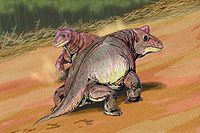
Tapinocephalia
Encyclopedia
The tapinocephalians are one of the major groups of dinocephalia
n therapsids. Unlike anteosaur
s and estemmenosuchids
, tapinocephalians are mainly from Africa
and only one species is found in the north - Ulemosaurus
from Russia
. The tapinocephalians are divided into three clades, Styracocephalidae, Titanosuchidae
, and the Tapinocephalidae
. Notable tapinocephalians include Moschops
, Tapinocephalus
, and Titanosuchus
.
Earlier tapinocephalians were carnivorous to omnivorous. One such group of carnivorous/omnivorous tapinocephalians are the Titanosuchidae
. These were long-tailed predators that hunted other herbivorous therapsids. Later tapinocephalians were herbivorous.
Tapinocephalians were hard-headed and might have used their thick skulls for head-butting. Some had horns, some did not.
Dinocephalia
Dinocephalia are a clade of large early therapsids that flourished during the Middle Permian, but became extinct leaving no descendants.-Description:...
n therapsids. Unlike anteosaur
Anteosaur
Anteosaurs are a group of large, primitive carnivorous Dinocephalians , with huge canines and incisors and short limbs, that are known from the Middle Permian of South Africa, Russia, and China. The largest grew to very large size, with skulls 50 to 80 cm long, and were the largest predators...
s and estemmenosuchids
Estemmenosuchidae
Estemmenosuchidae are a family of large, very early herbivorous mammal-like reptiles that flourished during the Middle Permian period. They are distinguished by horn-like structures, probably for display or agonistic behavior. Apart from the best known genus, Estemmenosuchus, the group is poorly...
, tapinocephalians are mainly from Africa
Africa
Africa is the world's second largest and second most populous continent, after Asia. At about 30.2 million km² including adjacent islands, it covers 6% of the Earth's total surface area and 20.4% of the total land area...
and only one species is found in the north - Ulemosaurus
Ulemosaurus
Ulemosaurus svijagensis was a dinocephalian synapsid that lived 250 million years ago, at Isheevo in Russian Tatarstan.Only several partial skeletons and skulls have been found. The skull bones are extremely dense: about 10 cm at its thickest. This thickening is possibly related to...
from Russia
Russia
Russia or , officially known as both Russia and the Russian Federation , is a country in northern Eurasia. It is a federal semi-presidential republic, comprising 83 federal subjects...
. The tapinocephalians are divided into three clades, Styracocephalidae, Titanosuchidae
Titanosuchidae
The titanosuchids were carnivorous to omnivorous tapinocephalid dinocephalians. As with other tapinocephalids, they had thick-skulls probably for head-butting. They appeared in the Middle Permian. They had large canine teeth, and their incisors were very strong...
, and the Tapinocephalidae
Tapinocephalidae
Tapinocephalidae is an advanced family of tapinocephalians. They were all herbivores. They were giants of their time, weighing from 500 to 1000 kg and possibly over 1 or 2 tonnes in weight. They are known from South Africa and Russia. The tapinocephalid skull is very thick, probably used for...
. Notable tapinocephalians include Moschops
Moschops
Moschops is an extinct genus of therapsid that lived in the Late Permian, around 255 million years ago. Therapsids were proto-mammals , which were the dominant land animals. Five metres long, Moschops was the largest land animal of its time, a herbivore preyed on by other therapsids...
, Tapinocephalus
Tapinocephalus
Tapinocephalus is a genus of large herbivorous dinocephalian that lived during the Middle Permian Period. These stocky, barrel-bodied animals were characterised by a massive bony skull roof and short weak snout...
, and Titanosuchus
Titanosuchus
Titanosuchus ferox was a dinocephalian therapsid that lived in the Mid Permian epoch in South Africa. Despite the name, it was not related to crocodiles....
.
Earlier tapinocephalians were carnivorous to omnivorous. One such group of carnivorous/omnivorous tapinocephalians are the Titanosuchidae
Titanosuchidae
The titanosuchids were carnivorous to omnivorous tapinocephalid dinocephalians. As with other tapinocephalids, they had thick-skulls probably for head-butting. They appeared in the Middle Permian. They had large canine teeth, and their incisors were very strong...
. These were long-tailed predators that hunted other herbivorous therapsids. Later tapinocephalians were herbivorous.
Tapinocephalians were hard-headed and might have used their thick skulls for head-butting. Some had horns, some did not.


